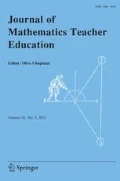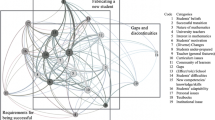Abstract
This study explores narratives about critical moments in mathematics learning written by K-8 pre-service teachers’ (PSTs) in the United States over a 20-year period. These critical moments, such as a single memorable task, course, test, or comment from a teacher, had a powerful and sustained impact on PSTs’ mathematics identities, which they carried with them as they entered the teaching profession. We classified narratives using McCulloch et al. (Sch Sci Math 113(8):380–389, 2013) and Drake’s (J Math Teach Educ 9(6):579–608, 2006) categories and found a potentially new category, Taking the Reins. We also classified PSTs’ mathematics orientations as either relational (oriented toward creative problem solving and conceptual understanding) or instrumental (enacting rote procedures without meaning) (Skemp in Math Teach 77(1):20–26, 1976). Many PSTs identified a causal relationship between their mathematics orientations and narrative arcs: relational learning opportunities encouraged positive narratives, while instrumental learning opportunities either resulted in negative narrative arcs or positive but fragile mathematics identities that crumbled under minor stress. We found little variation over time in the nature and prevalence of the narrative arcs and mathematics orientations, suggesting that any changes in mathematics teaching practices over time were not reflected in students’ learning experiences.




Similar content being viewed by others
Notes
These sketches were a required part of a participation grade and were assessed by the course instructor based upon completion (but not content). They were used to stimulate discussion during the class to share both positive and negative mathematics experiences as part of building a safe space and understanding the potential mathematics experiences of PST’s future students.
The AP (advanced placement) exams are used in the U.S. to demonstrate that a student has covered a first-year college course during high school and should receive college credit. The GRE exams are used for graduate school admittance. Both are typically only taken by students who are very strong academically.
References
Andersson, A. (2011). A “Curling teacher” in mathematics education: Teacher identities and pedagogy development. Mathematics Education Research Journal, 23(4), 437–454.
Ball, D. L. (1990). Breaking with experience in learning to teach mathematics: The role of a preservice methods course. For the Learning of Mathematics, 10(2), 10–16.
Beilock, S. L., Gunderson, E. A., Ramirez, G., & Levine, S. C. (2010). Female teachers’ math anxiety affects girls’ math achievement. Proceedings of the National Academy of Sciences of the United States of America, 107(5), 1860–1863.
Boaler, J. (2013). The stereotypes that distort how americans teach and learn math. The Atlantic, 1–21. https://www.theatlantic.com/education/archive/2013/11/the-stereotypes-that-distort-how-americans-teach-and-learnmath/281303/. Accessed 22 Oct 2020.
Boaler, J. (2016). Mathematical mindsets: Unleashing students’ potential through creative math inspiring messages and innovative teaching. California: Jossey-Bass.
Brady, P., & Bowd, A. (2005). Mathematics anxiety, prior experience and confidence to teach mathematics among pre-service education students. Teachers and teaching: Theory and Practice, 11(1), 37–46.
Brown, T., & McNamara, O. (2011). Becoming a mathematics teacher: Identity and identifications. Berlin: Springer Science & Business Media.
Bruner, E. M. (1986). Experience and its expressions. In V. W. Turner & E. M. Bruner (Eds.), The anthropology of experience (pp. 3–32). Illinois: University of Illinois Press.
Carter, K. (1993). The place of story in the study of teaching and teacher education. Educational Researcher, 22(1), 5–18.
Cribbs, J. D., Hazari, Z., Sonnert, G., & Sadler, P. M. (2015). Establishing an explanatory model for mathematics identity. Child Development, 86(4), 1048–1062.
Darragh, L. (2016). Identity research in mathematics education. Educational Studies in Mathematics, 93(1), 19–33.
Drake, C. (2006). Turning points: Using teachers’ mathematics life stories to understand the implementation of mathematics education reform. Journal of Mathematics Teacher Education, 9(6), 579–608.
Drake, C., Spillane, J. P., & Hufferd-Ackles, K. (2001). Storied identities: Teacher learning and subject-matter context. Journal of Curriculum Studies, 33(1), 1–23.
Ellsworth, J. Z., & Buss, A. (2000). Autobiographical stories from preservice elementary mathematics and science students: Implications for K-16 teaching. School Science and Mathematics, 100(7), 355–364.
Geertz, C., (1973). The Interpretation of Cultures. Basic Books, Inc. https://doi.org/https://doi.org/10.4324/9781315613192
Goldin, G. A., Hannula, M. S., Heyd-Metzuyanim, E., Jansen, A., Kaasila, R., Lutovac, S., et al. (2016). Attitudes, beliefs, motivation, and identity in mathematics education: An overview of the field and future directions. Berlin: Springer.
Graven, M., & Heyd-Metzuyanim, E. (2019). Mathematics identity research: The state of the art and future directions: Review and introduction to ZDM special issue on identity in mathematics education. ZDM - international Journal on Mathematics Education, 51(3), 361–377.
Grootenboer, P., & Marshman, M. (2016). The affective domain, mathematics, and mathematics education. In Mathematics, affect and learning: Middle school students’ beliefs and attitudes about mathematics education (pp. 13–34). Springer.
Gutiérrez, R. (2018). The need to rehumanize mathematics. In I. M. Goffney, R. Gutiérrez, & M. Boston (Eds.), rehumanizing mathematics for black, indigenous, and latinx students (pp. 1–10). Reston: National Council of Teachers of Mathematics.
Hodges, T. E., & Hodge, L. L. (2017). Unpacking personal identities for teaching mathematics within the context of prospective teacher education. Journal of Mathematics Teacher Education, 20(2), 101–118.
Kaasila, R. (2007). Mathematical biography and key rhetoric. Educational Studies in Mathematics, 66(3), 373–384.
Kaasila, R., Hannula, M. S., Laine, A., & Pehkonen, E. (2008). Socio-emotional orientations and teacher change. Educational Studies in Mathematics, 67(2), 111–123.
Kasten, S. E., Austin, C., & Jackson, C. (2014). Am I a mathematics teacher who teaches middle grades or a middle grades teacher who teaches mathematics? Untangling the multiple identities of preservice teachers. Middle Grades Research Journal, 9(2), 127–140.
Lopresto, K. D., & Drake, C. (2004). What’s Your (Mathematics) Story? Teaching Children Mathematics, 11(5), 266–271.
Lutovac, S., & Kaasila, R. (2014). Pre-service teachers’ future-oriented mathematical identity work. Educational Studies in Mathematics, 85(1), 129–142.
Lutovac, S., & Kaasila, R. (2019). Methodological landscape in research on teacher identity in mathematics education: A review. ZDM - International Journal on Mathematics Education, 51(3), 505–515.
McCulloch, A. W., Marshall, P. L., DeCuir-Gunby, J. T., & Caldwell, T. S. (2013). Math autobiographies: A window into teachers’ identities as mathematics learners. School Science & Mathematics, 113(8), 380–389.
McGee, E. O. (2015). Robust and fragile mathematical identities : A framework for exploring racialized experiences and high achievement among black college students. Journal for Research in Mathematics Education, 46(5), 599–625.
McGlynn-Stewart, M. (2010). Listening to students, listening to myself: Addressing pre-service teachers’ fears of mathematics and teaching mathematics. Studying Teacher Education, 6(2), 175–186.
Mead, G. H. (1913). The social self. Journal of Philosophy, Psychology and Scientific Methods, 10, 374–380.
Mishler, E. G. (1999). Storylines: Craftartists’ narratives of identity. Cambridge: Harvard University Press.
NCTM. (1989). Curriculum and evaluation standards for school mathematics. Reston: National Council of Teachers of Mathematics.
NCTM. (2000). Principles and standards for school mathematics. Reston: National Council of Teachers of Mathematics.
Radovic, D., Black, L., Williams, J., & Salas, C. E. (2018). Towards conceptual coherence in the research on mathematics learner identity: A systematic review of the literature. Educational Studies in Mathematics, 99(1), 21–42.
Ramirez, G., & Beilock, S. L. (2011). Writing about testing worries boosts exam performance in the classroom. Science, 331, 211–214.
Relich, J. (1996). Gender, self-concept and teachers of mathematics: Effects on attitudes to teaching and learning. Educational Studies in Mathematics, 30(2), 179–195.
Schultz, K., & Ravitch, S. M. (2012). Narratives of learning to teach: Taking on professional identities. Journal of Teacher Education, 64(1), 35–46.
Senk, S. L., & Thompson, D. R. (2003). Standards-based mathematics curricula: What are they? What do students learn? New Jersey: Lawrence Erlbaum Associates.
Sfard, A., & Prusak, A. (2005). Telling identities: In search of an analytic tool for investigating learning as a culturally shaped activity. Educational Researcher, 34(4), 14–22.
Sikes, P. J., Measor, L., & Woods, P. (1985). Teacher careers: Crises and continuities. Routledge: Taylor & Francis.
Skemp, R. R. (1976). Relational understanding and instrumental understanding. Mathematics Teaching, 77(1), 20–26.
Spillane, J. P. (2000). A fifth-grade teacher’s reconstruction of mathematics and literacy teaching: exploring interactions among identity, learning, and subject matter. The Elementary School Journal, 100(4), 307.
Stipek, D. J., Givvin, K. B., Salmon, J. M., & MacGyvers, V. L. (2001). Teachers’ beliefs and practices related to mathematics instruction. Teaching and Teacher Education, 17(2), 213–226.
van Putten, S., Stols, G., & Howie, S. (2014). Do prospective mathematics teachers teach who they say they are? Journal of Mathematics Teacher Education, 17(4), 369–392.
Author information
Authors and Affiliations
Corresponding author
Additional information
Publisher's Note
Springer Nature remains neutral with regard to jurisdictional claims in published maps and institutional affiliations.
Rights and permissions
About this article
Cite this article
Machalow, R., Goldsmith-Markey, L.T. & Remillard, J.T. Critical moments: pre-service mathematics teachers’ narrative arcs and mathematical orientations over 20 years. J Math Teacher Educ 25, 35–61 (2022). https://doi.org/10.1007/s10857-020-09479-9
Accepted:
Published:
Issue Date:
DOI: https://doi.org/10.1007/s10857-020-09479-9




